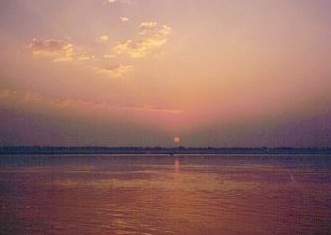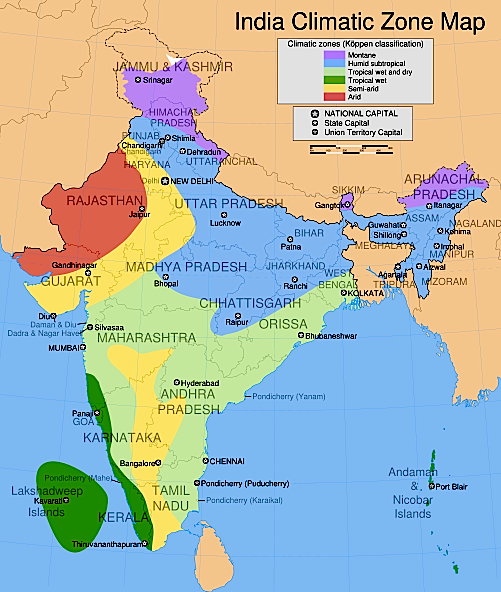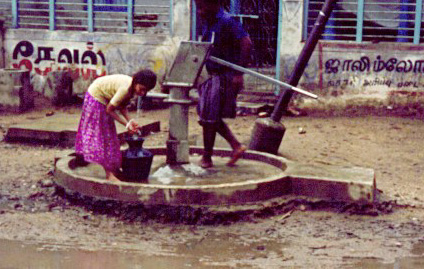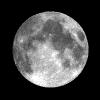"India is a state encompassing a civilization.
It includes a multitude of ethnic and linguistic groups which share a common cultural background."

Dawn along the Ganges in Varanasi. JVS, 1989.
India

"Indian society encompasses a spectrum representative of all of mankind from the desperately poor eking out a living in remote rural areas to metropolitan professionals in the most advanced lines of work and highly talented scientists operating at the cutting edge of research."
"India thus got a head start in the 'knowledge economy' of the new century. From 1980 to the present the share of exports in GDP rose from 6 to 16 percent. At the same time gross domestic savings rate increased from about 20 to 30 percent. This is the secret of India's ascent."
Asian Giant. pp. xii-xiii.
"This confidence of Indian entrepreneurs is also based on a stable democratic polity vibrant nature of Indian democracy is often shown. . . . "
p. xiii.
The largest democracy on Earth, today the nation of India is at once an industrially developed and agrarian powerhouse while it is in many respects a pre-modern nation of villages and customs rapidly colliding with the twenty-first century "telecom–suffused" world of increasing homogeneity.
Sophisticated and ageless, materially modern, with a long tolerance of diversity that springs from a quite ancient diversity and spirituality, this immense nation is destined to be the most populated state in the world within a decade.
Far from the older Mauryan, later Mogul, and recent European centers or even current clusters of population, the Indus and Gangetic archaeological sites date to periods as old as Egyptian and Sumerian civilizations. As one of three centers of rice domestication, India's wildness is still extant in pockets across the continent and is readily matched by enormous regional variability and sublime geography.
For the very face of India tells the geological story of a relentless passage from Africa and a climatically altering collision with Asia that is seen among the highest peaks of Asia and the deep oceanic ridges that scar the path taken since the great southern continent of Gondwana split up 50 million years ago setting India adrift in a great equatorial Ocean that now bears its name.
Tens of thousands of years ago, humans migrated out of Africa, by way of the Arabian peninsula to inhabit India, south Asia, and the Australasian islands. This occurred prior to the domestication of plants and animals, although the millet dependent populations of Africa and India today suggest a continuing network of commercial interaction of people along the east, north and west sides or three coasts of the Indian Ocean. Contact among India, Indonesia, Cambodia and China is also of ancient origins.
The Rise of an Asian Giant
Contents
- Building a Democratic Nation
- The Emergence of National Coalitions
- The Tensions of Federalism
- A Role in World Affairs
- The Argument of Power
- Liberalizing a Hidebound Economy
- Sick Mills and Strong Power looms
- Diamonds, Garments, and Software
- The Quest for Supercomputers
- Agriculture Crisis or Promise?
- The Giant's Shackles: Water, Energy, and Infrastructure
- Caste in a Changing Society
- The Boom of a Demographic Dividend
- The Demand for Education
- The New Middle Class
- The Persistence of Poverty
- The Splendor of the Media
- A Dynamic Diaspora

"My aim in tracing the rise of India as an Asian giant is that of understanding the present in terms of historical background and its future potential."
Dietmar Rothermund, p. ix.
Building a Democratic Nation

"India is a state encompassing a civilization. It includes a multitude of ethnic and linguistic groups which share a common cultural background. Its historical continuity is amazing. The art of story-telling has characterized this civilization throughout."
"Creativity has been India's hallmark."
Traditionally mountains and seas were not treated as barriers by ancient Indian peoples.
"In fact the mountain people never conceived of the Himalayas as a boundary and they 'transgressed' it in many ways."
The orthodox prejudice against crossing the kala pani (black water) was not shared by them."
"The poor people from northern India who were transported to Fiji as indentured servants to work sugar plantations did not refer to themselves as 'Indians' but as girmityas. The word girmit was a Hindi neologism derived from 'agreement', the document which bound them to their servitude."
p. 1.

Dietmar Rothermund, India, The Rise of an Asian Giant. New Haven: Yale University Press, 2008.

